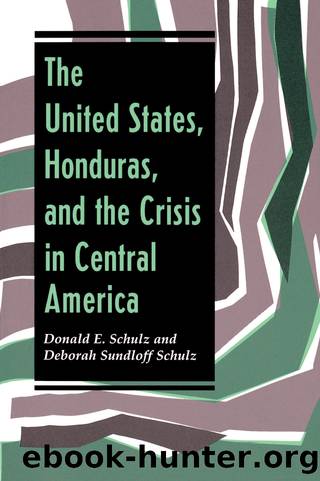The United States, Honduras, and the Crisis in Central America by Deborah Sundloff Schulz

Author:Deborah Sundloff Schulz [Schulz, Deborah Sundloff]
Language: eng
Format: epub
Tags: Political Science, General
ISBN: 9780429964329
Google: d_7EDwAAQBAJ
Publisher: Routledge
Published: 2018-02-06T05:48:06+00:00
Esquipulas: Two Approaches to Compliance
The Arias plan contained both opportunities and risks, and it soon became apparent that some governments were more willing to incur the latter than others. Though the accord required all of the signatories to comply with its terms, there was an unspoken consensus that only Nicaragua would be held strictly accountable Both regionally and in the United States, attention was focused primarily on the issue of Sandinista compliance. Still, the agreement was about as favorable as Managua could have hoped. If fully implemented, it would almost certainly have meant the end of the contras. Deprived of their foreign sanctuaries and arms supplies, they would have withered away. They were not recognized as a negotiating force; the internal "dialogue" was to be limited to the unarmed opposition and those who accepted amnesty. With the guerrillas thus weakened, there seemed an excellent chance that order could be restored and Sandinista hegemony maintained. Beyond that, Nicaragua desperately needed peace. Tens of thousands of people had been killed; damage to the economy exceeded US$2 billion. The populace was exhausted. Without peace, the government had no hope of attaining its socioeconomic goals. The society would continue to disintegrate. The revolution would be destroyed.
The plan was not without risk. As Alexis de Tocqueville recognized long ago, the most perilous moment for a bad government is when it seeks to mend its ways. During the Sandinistas' years in power, the economy had been largely destroyed, and living conditions had plunged to Depression-era levels. Although government policies were only part of the reason for this decline, increasing numbers of Nicaraguans held the Sandinistas responsible. Beneath the system of controls imposed by the regime, discontent seethed. There was no way of gauging the breadth or depth of this alienation or predicting the public response once those controls were lifted.
On balance, however, the agreement was clearly in the Sandinistas' interests, and they embraced it enthusiastically. The government indicated that it would meet its obligations even if the other signatories did not. It set up a national reconciliation commission that was reasonably representative of both pro-and antigovernment views and chaired by the regime's most influential critic, Archbishop Miguel Obando y Bravo. Censorship was suspended and an existing amnesty law broadened. Several Catholic priests who had been expelled from the country for their procontra activities were allowed to return. Nicaragua's most influential newspaper, La Prertsa, closed for sixteen months for its opposition to the regime, was allowed to reopen. The ban on Radio Catolica was lifted. The so-called Law of the Absent, which allowed the seizure of property of those who had gone into exile, was repealed. A dialogue was opened with opposition parties. In early November, under increasing international pressure, the government agreed to initiate indirect cease-fire talks with the contras. The following month, the two sides met in the Dominican Republic and began to negotiate their differences. The road ahead would be long and difficult, but at least progress was finally being made.
In contrast, in Honduras the armed forces and government viewed the agreement with profound suspicion.
Download
This site does not store any files on its server. We only index and link to content provided by other sites. Please contact the content providers to delete copyright contents if any and email us, we'll remove relevant links or contents immediately.
| Belize | Costa Rica |
| El Salvador | Guatemala |
| Honduras | Nicaragua |
| Panama |
Cat's cradle by Kurt Vonnegut(15257)
Pimp by Iceberg Slim(14433)
4 3 2 1: A Novel by Paul Auster(12329)
Underground: A Human History of the Worlds Beneath Our Feet by Will Hunt(12052)
The Radium Girls by Kate Moore(11970)
Wiseguy by Nicholas Pileggi(5707)
The Fire Next Time by James Baldwin(5380)
Perfect Rhythm by Jae(5354)
American History Stories, Volume III (Yesterday's Classics) by Pratt Mara L(5274)
Paper Towns by Green John(5136)
Pale Blue Dot by Carl Sagan(4953)
A Higher Loyalty: Truth, Lies, and Leadership by James Comey(4905)
The Mayflower and the Pilgrims' New World by Nathaniel Philbrick(4458)
The Doomsday Machine by Daniel Ellsberg(4449)
Killers of the Flower Moon: The Osage Murders and the Birth of the FBI by David Grann(4409)
The Sympathizer by Viet Thanh Nguyen(4338)
Too Much and Not the Mood by Durga Chew-Bose(4302)
The Borden Murders by Sarah Miller(4276)
Sticky Fingers by Joe Hagan(4143)
